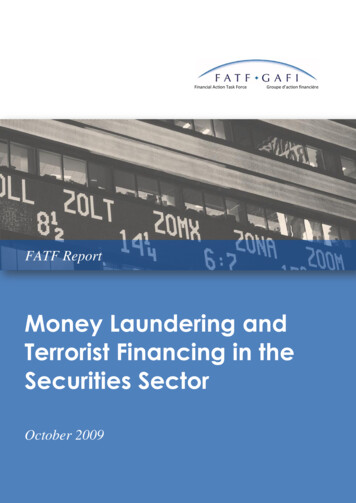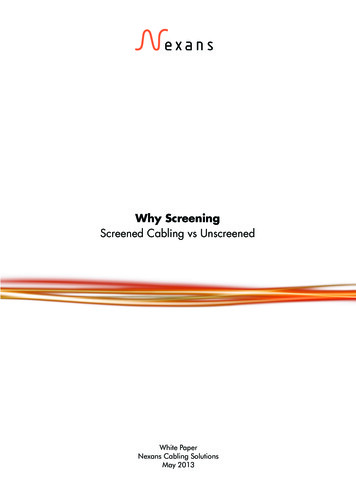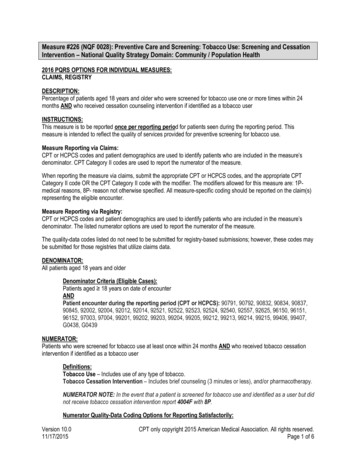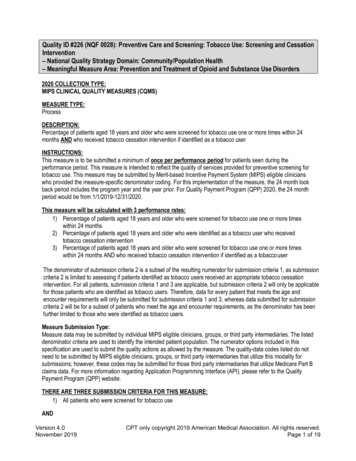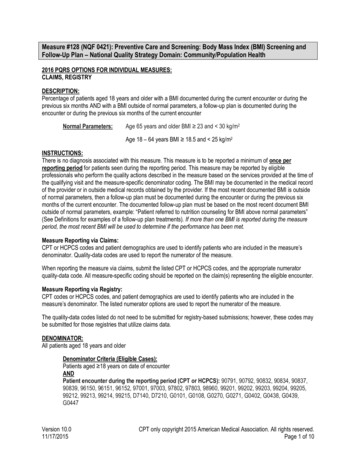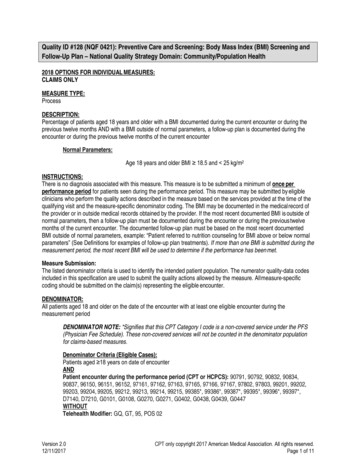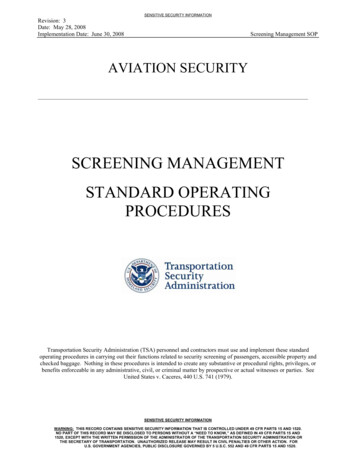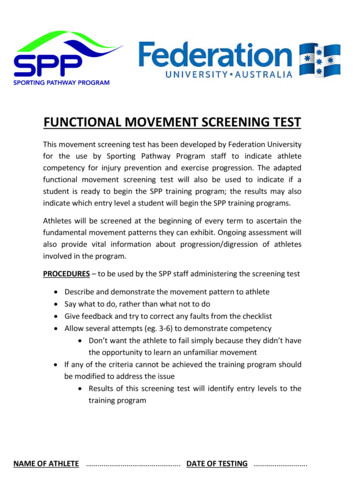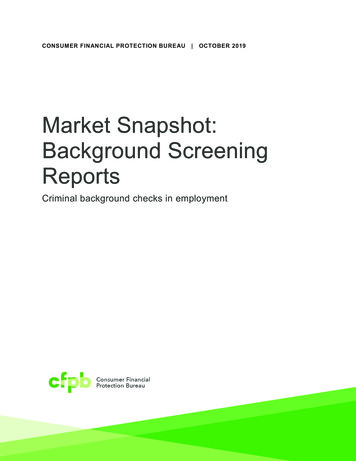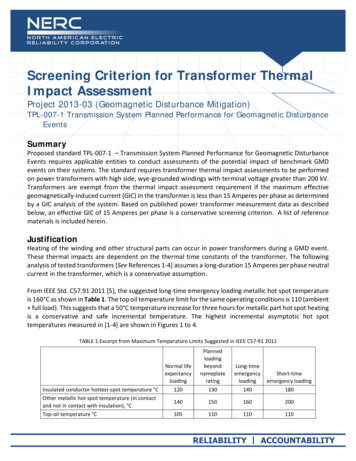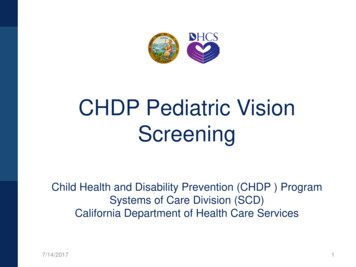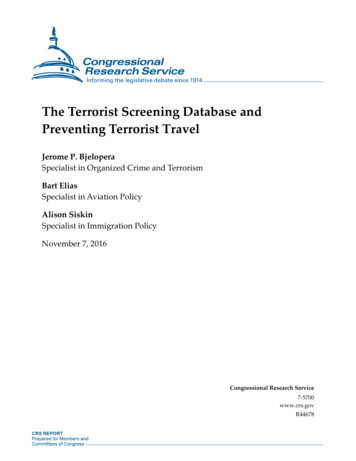
Transcription
The Terrorist Screening Database andPreventing Terrorist TravelJerome P. BjeloperaSpecialist in Organized Crime and TerrorismBart EliasSpecialist in Aviation PolicyAlison SiskinSpecialist in Immigration PolicyNovember 7, 2016Congressional Research Service7-5700www.crs.govR44678
The Terrorist Screening Database and Preventing Terrorist TravelSummaryAfter the terrorist attacks of September 11, 2001, the federal government developed a unifiedregimen to identify and list known or suspected terrorists. The regimen has received repeatedcongressional attention, and this report briefly discusses for congressional policymakers how theU.S. government fashions and uses the Terrorist Screening Database (TSDB) to achieve such anend. It also discusses how the federal government engages in two travel-related screeningprocesses—visa screening and air passenger screening. Both processes involve subsets of theTerrorist Screening Database.The Terrorist Screening Database (TSDB)The TSDB lies at the heart of federal efforts to identify and share information among U.S. lawenforcement about identified people who may pose terrorism-related threats to the United States.It is managed by the Terrorist Screening Center (TSC), a multi-agency organization created bypresidential directive in 2003 and administered by the Federal Bureau of Investigation (FBI). TheTSDB includes biographic identifiers for those known either to have or be suspected of havingties to terrorism. In some instances it also includes biometric information on such people. It storeshundreds of thousands of unique identities. Portions of the TSDB are exported to data systems infederal agencies that perform screening activities such as background checks, reviewing therecords of passport and visa applicants, official encounters with travelers at U.S. border crossings,and air passenger screening.Foreign Nationals Traveling to the United StatesTwo broad classes of foreign nationals are issued visas under the Immigration and Nationality Act(INA): immigrants and nonimmigrants. Many visitors, however, enter the United States withoutvisas through the Visa Waiver Program (VWP). Under the VWP, foreign nationals from 38countries with agreements with the United States—including most countries in the EuropeanUnion—do not need visas to enter the United States for short-term business or tourism and areinstead vetted using biographic information to authenticate and screen individuals.Screening AliensDepartment of State (DOS) consular officers check the background of all visa applicants in“lookout” databases that draw on TSDB information and other counterterrorism information suchas the material housed in the National Counterterrorism Center’s Terrorist Identities DatamartEnvironment. DOS specifically uses the Consular Lookout and Support System (CLASS)database, which surpassed 42.5 million records in 2012. Aliens entering through the VWP havebeen vetted through the Electronic System for Travel Authorization (ESTA), which checks themagainst the TSDB. In addition, before an international flight bound for the United States departsfrom a foreign airport, Customs and Border Protection (CBP) officers screen the passengermanifest. CBP inspectors also perform background checks and admissibility reviews at the portsof entry that draw on information from the TSDB.Screening at the Transportation Security AdministrationThe Transportation Security Administration (TSA) has initiated a number of risk-based screeninginitiatives to focus its resources and apply directed measures based on intelligence-drivenassessments of security risk. A cornerstone of TSA’s risk-based initiatives is the PreCheckprogram. PreCheck is TSA’s latest version of a trusted traveler program that has been modeledCongressional Research Service
The Terrorist Screening Database and Preventing Terrorist Travelafter CBP programs. Under the PreCheck regimen, participants are vetted through a backgroundcheck process (including screening against terrorist watchlist information). At selected airports,they are processed through expedited screening lanes, where they can keep shoes on and keepliquids and laptops inside carry-on bags.All passengers flying to or from U.S. airports are vetted using the TSA’s Secure Flight program.Secure Flight involves information from the TSDB housed in the No Fly List, Selectee List, andExpanded Selectee List to vet passenger name records. The No Fly List includes identities ofindividuals who may present a threat to civil aviation and national security. Listed individuals arenot allowed to board a commercial aircraft flying into, out of, over, or within U.S. airspace; thisalso includes point-to-point international flights operated by U.S. carriers. The Selectee Listincludes individuals who must undergo additional security screening before being allowed toboard a commercial aircraft. The Expanded Selectee List was created as an extra security measurein response to a failed attempt to trigger an explosive by a foreign terrorist onboard a U.S.-boundflight on December 25, 2009. It screens against all TSDB records that include a person’s first andlast name and date of birth that are not already on the No Fly or Selectee lists.Congressional Research Service
The Terrorist Screening Database and Preventing Terrorist TravelContentsThe Terrorist Screening Database. 1The Terrorist Screening Center, the Hub of Watchlisting . 1Nominations . 4Verification of Identities for the TSDB and Export to Federal Data Systems . 4Making the TSDB Cut . 5Export. 7Screening . 9Visa and Air Traveler Screening . 10Overview of the Visa Screening Process . 10Immigration Law and Terrorism . 10National Security and Public Safety Reviews. 12Air Passenger Risk-Based Screening . 15Identifying Low-Risk Travelers . 15Behavioral Detection Approaches. 17Terrorist Watchlists in Aviation . 17Passenger Redress . 18FiguresFigure 1. U.S. Counterterrorism Watchlisting Regimen . 3Figure 2. Nominations and Rejections to Terrorist Screening Database, . 7Figure 3. Foreign Nationals Denied Visas under Terrorist Grounds of Inadmissibility . 15AppendixesList of Abbreviations . 20ContactsAuthor Contact Information . 20Acknowledgments . 21Congressional Research Service
The Terrorist Screening Database and Preventing Terrorist Travelfter the terrorist attacks of September 11, 2001, the federal government developed aunified regimen to identify and list known or suspected terrorists. The regimen hasreceived repeated congressional attention, and this report briefly discusses forcongressional policymakers how the U.S. government fashions and uses the Terrorist ScreeningDatabase (TSDB) to achieve such an end.1 It also discusses how the federal government engagesin two travel-related screening processes—visa screening and air passenger screening. Bothprocesses involve subsets of the Terrorist Screening Database.AThe TSDB as well as terrorist watchlisting and screening efforts are of keen congressionalinterest. This report endeavors to offer policymakers an overview of these issues to help in thedevelopment of policy and oversight. The material herein is drawn from publicly availableinformation released by federal agencies as well as other open source material. The report doesnot evaluate the TSDB or federal programs designed to prevent terrorist travel.The Terrorist Screening DatabaseThe Terrorist Screening Database (TSDB, commonly referred to as the terrorist watchlist)2 lies atthe heart of federal efforts to collect and share information with U.S. law enforcement andsecurity agencies about identified people who may pose terrorism-related threats to the UnitedStates.3 It is managed by the Terrorist Screening Center (TSC) and includes biographic identifiersfor those known either to have or be suspected of having ties to terrorism. In some instances italso includes biometric information on such people.4 It stores hundreds of thousands of uniqueidentities.5 Portions of the TSDB are exported to data systems in federal agencies that performscreening activities such as background checks, reviewing the records of passport and visaapplicants, and official encounters with travelers at U.S. border crossings.6The Terrorist Screening Center, the Hub of WatchlistingThe TSC, a multi-agency organization administered by the Federal Bureau of Investigation (FBI),maintains the TSDB.7 The TSC was created by presidential directive in 2003 in response to theterrorist attacks of September 11, 2001.8 Before the TSC consolidated federal watchlisting efforts,1For an example, see U.S. Congress, House Committee on Homeland Security, Subcommittee on TransportationSecurity, Safeguarding Privacy and Civil Liberties while Keeping Our Skies Safe, hearing, 113th Cong., 2nd sess.,September 18, 2014.2CRS Report R44529, The Terrorist Screening Database: Background Information, by Jerome P. Bjelopera.3Testimony of Christopher M. Piehota, Director, Terrorist Screening Center, Federal Bureau of Investigation, in U.S.Congress, House Committee on Homeland Security, Subcommittee on Transportation Security, Safeguarding Privacyand Civil Liberties while Keeping Our Skies Safe, hearing transcript, 113th Cong., 2nd sess., September 18, 2014(Hereinafter: Piehota, Testimony).4Testimony of Timothy J. Healy, (former) Director, Terrorist Screening Center, Federal Bureau of Investigation, inU.S. Congress, House Committee on the Judiciary, Sharing and Analyzing Information to Prevent Terrorism, hearingtranscript, March 24, 2010. Jeremy Scahill, Ryan Devereaux, “Watch Commander: Barak Obama’s Secret TerroristTracking System, by the Numbers,” The Intercept, August 5, 2014 (Hereinafter: Scahill and Devereaux, “WatchCommander”).5Department of Justice, Office of Inspector General, “Audit of the Federal Bureau of Investigation’s Management ofTerrorist Watchlist Nominations,” March 2014, footnote 10, p. 2 (Hereinafter: Department of Justice, Office ofInspector General, “Audit”).6Ibid. p. 4.7See rorist-screening-center.8Ibid. The TSC and the TSDB stem from Homeland Security Presidential Directive/HSPD–6—Directive on(continued.)Congressional Research Service1
The Terrorist Screening Database and Preventing Terrorist Travelnumerous separate watchlists were maintained by different federal agencies. The information inthese lists was not necessarily shared or compared.9The efforts that surround the federal watchlisting regimen can be divided into three broadprocesses centered on the TSDB: Nomination, which involves the identification of known or suspected terroristsvia intelligence collection or law enforcement investigations. The U.S.government has a formal watchlist nomination process.10Verification of identities for the TSDB and export of data to screening systems,which involves managing records in the TSDB, as well as the compiling andexport of special TSDB subsets for various intelligence or law enforcement endusers (screeners).Screening, which involves end users—screeners—checking individuals oridentities they encounter against information from the TSDB that is exported toscreening databases.11 These databases12 include the No Fly List and the Selecteeand Expanded Selectee lists for airline passenger screening; the Department ofState’s Consular Lookout and Support System (CLASS); the FBI’s NationalCrime Information Center (NCIC); the TECS (not an acronym) system for borderand port of entry screening; and the military base access and screening system.(In FY2011, there were “more than 1.2 billion queries against [the TSDB].”)13The screening and vetting processes can yield more information on particularsubjects that may be fed back into the TSDB.14(See Figure 1 for a visual depiction of the federal agencies involved in watchlisting.)(.continued)Integration and Use of Screening Information to Protect against Terrorism, September 16, 2003. In HSPD-6, the entitydescribed as the Terrorist Threat Integration Center became the TSC.9Federal Bureau of Investigation, “Ten Years After: The FBI since 9/11, Terrorist Screen
screening activities such as background checks, reviewing the records of passport and visa applicants, and official encounters with travelers at U.S. border crossings.6 The Terrorist Screening Center, the Hub of Watchlisting The TSC, a multi-agency organization administered by the Federal Bureau of
